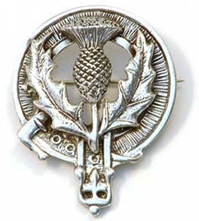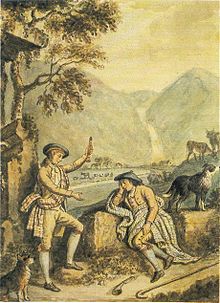 |
|

Best viewed in
|
The blue bonnet was a type of soft woolen hat that for several hundred years was the customary working wear of Scottish laborers and farmers. Although a particularly broad and flat form was associated with the Scottish Lowlands, where it was sometimes called the "scone cap", the bonnet was also worn in parts of northern England and became widely adopted in the Highlands. A substantial hand knitting industry is believed to have developed in Scotland by the late 15th century. Bonnetmakers produced broad, flat knitted caps in imitation of the velvet caps popular amongst the upper classes of the time. Dyed with blue or grey vegetable dyes, they became popular with the peasantry and by the end of the 16th century, the bonnet had been adopted nearly universally by men throughout the Lowlands, although it did not become widely worn in the Highlands until the following century. By 1700 Martin Martin described Highlanders as mainly wearing thick woolen bonnets of blue or grey. It was the bonnet's blue color, as well as, perhaps, its Lowland and peasant origins, that influenced its adoption as a badge of the Covenanters, who used blue to distinguish themselves from their Royalist opponents and their red cockades and ribbons. During the 18th century the bonnet was, to outsiders, the most readily identifiable Scottish piece of clothing in the popular imagination. Tartan would occupy this role in the following century. Despite its earlier association with the Covenanters, adorned with a white cockade the blue bonnet was also adopted as an emblem of Jacobitism. Its political symbolism became overt: one night in December 1748, over two years after the failure of the 1745 Jacobite rising, someone scaled the Edinburgh Parliament House and dressed the lion in the Scottish royal arms in a white wig, blue bonnet, and large white cockade. The association was reinforced by later nostalgic Jacobite songs, such as "Blue bonnets over the border", set down (and possibly written) by Sir Walter Scott, who himself affected to wear a bonnet in later life, dressing very much like "an old Border baron". The blue bonnet remained everyday wear for Lowland farmers until the end of the 18th century, but its use was gradually discontinued under the influence of fashion and increasingly industrialized clothing manufacture. A minister of a lowland parish of Angus, noting the increase in the use of imported cloth and clothing in his lifetime, wrote "in 1760 there were only two hats in the parish: in 1790 few bonnets are worn; the bonnet-maker trade in the next parish is given up". An 1825 dictionary described the bonnet as "formerly worn by the more antiquated peasantry". By the middle of the century the characteristic broad, flat Lowlander's bonnet, usually worn with clothing of homespun hodden grey and perhaps a woolen, black and white checkered maud (plaid), was said to have disappeared or survived only in the "degenerate form of a small round Kilmarnock bonnet worn pretty generally by ploughmen, carters and boys of the humbler ranks". Reflecting the Victorian fascination with (and militarization of) Highland dress, the smaller Kilmarnock or Balmoral bonnet, further elaborated with ribbons, a diced border, and a toorie, was incorporated into British military uniform during the 19th century. The informal version of the Balmoral, also adorned with a toorie, is often known as the Tam o' shanter, after a Robert Burns poem whose central character wears a "gude blue bonnet", though the more modern "tam" may be made of a wide range of materials. Like the English Monmouth cap, the true knitted blue bonnet is still made in small quantities for historical and military re-enactment groups.
|

